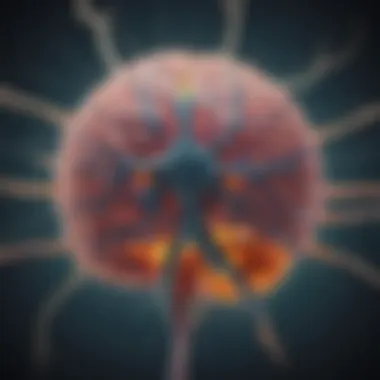Dopamine's Impact on Schizophrenia Explained


Intro
This article delves into the complex interplay between dopamine levels and schizophrenia. Recognizing schizophrenia as a multifaceted psychiatric disorder, characterized by disruptions in thought patterns, perceptions, and emotional responses is crucial. Dopamine, a neurotransmitter pivotal in many brain functions, has been a focal point of research in understanding the origins and manifestations of schizophrenia.
As we navigate through this exploration, pertinent themes include the biological underpinnings, historical perspectives, and cutting-edge research that augment our knowledge of these interconnections. This narrative is tailored for students, researchers, educators, and professionals aiming to deepen their comprehension of this significant subject.
Article Overview
Purpose of the Article
The primary goal of this article is to investigate the relationship between dopamine and schizophrenia. It seeks to unravel the neurobiological hypotheses, genetic aspects, and environmental influences that shape this connection. By synthesizing contemporary research findings, the article aspires to offer insights into the causes of schizophrenia while emphasizing the implications for therapeutic interventions.
Relevance to Multiple Disciplines
The inquiry into dopamine and schizophrenia intertwines several fields:
- Psychiatry: Understanding the mechanisms of schizophrenia aids in the development of effective treatments.
- Neuroscience: Analysis of dopamine pathways can offer insights into broader neural functions and their impact on behavior.
- Genetics: Investigating genetic markers associated with dopamine regulation can illuminate inherited risk factors.
- Pharmacology: Research on dopamine antagonists informs medication strategies that target schizophrenia symptoms.
This multidisciplinary relevance makes the topic essential for advancing psychiatric research and clinical practices.
Research Background
Historical Context
The exploration of dopamine's role in schizophrenia began notably in the mid-20th century with the introduction of antipsychotic medications. These drugs, particularly the dopamine antagonists, demonstrated effectiveness in alleviating positive symptoms of schizophrenia. Over the years, various hypotheses emerged, linking dopamine dysregulation to the disorder.
Key Concepts and Definitions
To comprehend the discussion fully, it is necessary to clarify key concepts:
- Dopamine: A neurotransmitter involved in pleasure, movement, and attention, playing a crucial role in reward systems.
- Schizophrenia: A severe mental disorder marked by a range of symptoms, such as hallucinations, delusions, and cognitive impairments.
- Neurotransmission: The process of communication between neurons through chemical signals, including dopamine.
Understanding these concepts lays the groundwork for a thorough analysis of their interrelations.
Prelude
The relationship between dopamine and schizophrenia is a focal point of psychiatric research. Understanding this connection can illuminate the mechanisms of a disorder that significantly impacts millions. Schizophrenia presents with profound disturbances in cognition, emotion, and behavior. Investigating how dopamine influences these aspects is crucial for several reasons.
First, acknowledging the biological underpinnings of schizophrenia opens pathways for targeted interventions. The dopamine hypothesis suggests that overactivity of dopamine pathways, particularly in subcortical regions, correlates strongly with psychotic symptoms. This connection can guide research toward more effective pharmacological treatments.
Second, the nuances of how dopamine dysfunction manifests can lead to enriched therapeutic strategies. By grasping how different dopamine pathways affect various symptoms, clinicians can tailor treatments to address specific patient needs. This may enhance patient outcomes and promote recovery.
Lastly, the intricate interplay between genetic and environmental factors in the context of dopamine signaling remains a rich area for exploration. Such insights can foster a holistic understanding of the disorder, paving the way for preventive measures and early interventions.
Ultimately, this article aims to synthesize current findings and offer a detailed perspective on the role of dopamine in schizophrenia. With an emphasis on evidence-based research, it seeks to equip scholars, practitioners, and interested individuals with a robust understanding of this essential topic in psychiatric medicine.
"Understanding the dopamine-schizophrenia connection is not merely academic; it holds the key to unlocking better treatment options."
"Understanding the dopamine-schizophrenia connection is not merely academic; it holds the key to unlocking better treatment options."
In investigating these themes, we delve deeper into the biological mechanisms, genetic influences, and environmental factors that affect dopamine levels, thereby elucidating the complex relationship between this neurotransmitter and schizophrenia.
Understanding Schizophrenia
Understanding schizophrenia is essential, as it allows for a deeper comprehension of its causes, symptoms, and treatment strategies. Schizophrenia is not merely a psychiatric disorder; it is a complex condition that affects the way an individual interprets reality. This understanding paves the way for effective interventions which may alleviate the significant burden on both the affected individuals and their families.


Defining Schizophrenia
Schizophrenia is a severe mental disorder characterized by distortions in thinking, perception, emotions, language, and sense of self. It often manifests through debilitating symptoms that can severely impair one’s ability to function in daily life. While the exact cause of schizophrenia remains elusive, it is generally accepted that a combination of genetic, neurobiological, and environmental factors plays a role.
Prevalence and Epidemiology
The prevalence of schizophrenia varies across populations, but it generally affects about 1% of the global population. Understanding its epidemiology helps identify groups that may be at a higher risk.
- Age of Onset: Schizophrenia typically emerges in late adolescence or early adulthood. The onset is often earlier in males than in females.
- Gender Differences: Men are more likely to experience symptoms earlier and may display more severe forms of the disorder than women.
- Cultural Factors: Variations in diagnosis and prevalence across cultures suggest that sociocultural context significantly influences how schizophrenia is perceived and treated.
Symptoms and Their Manifestations
Symptoms of schizophrenia are often categorized into three major types: positive, negative, and cognitive. Understanding these symptoms is crucial for early intervention and effective management.
- Positive Symptoms: These include hallucinations (often auditory), delusions, and thought disorders. These symptoms can drastically alter reality, causing significant distress.
- Negative Symptoms: Neglect of personal hygiene, withdrawal from social interactions, and a lack of motivation are common. These symptoms can be harder to recognize and often lead to social isolation.
- Cognitive Symptoms: These may involve impaired memory, attention deficits, and difficulties with executive functions. Cognitive symptoms can hinder an individual’s ability to engage in tasks requiring critical thinking.
Schizophrenia is not a singular experience but a spectrum of symptoms that necessitates a comprehensive understanding for effective treatment.
The Role of Neurotransmitters
Neurotransmitters are pivotal in maintaining the delicate balance of brain function and behavior. They are chemical messengers that transmit signals across synapses, allowing communication between neurons. Understanding their role is crucial in the context of disorders such as schizophrenia, where dysregulation can lead to profound disturbances in thought, perception, and emotion.
Dopamine: An Overview
Dopamine is one of the most studied neurotransmitters in relation to schizophrenia. It plays a central role in the brain's reward system and regulation of movement, but its influence extends beyond these functions. Anomalies in dopamine transmission have been linked to both positive and negative symptoms of schizophrenia.
Research suggests that hyperactivity in certain dopamine pathways, particularly the mesolimbic pathway, contributes to positive symptoms like hallucinations and delusions. Conversely, hypoactivity in the prefrontal cortex, which is associated with dopamine, is thought to relate to negative symptoms such as lack of motivation and social withdrawal. The complexity of dopamine's effects highlights the need for careful consideration in both research and clinical practice.
Notably, the dopamine hypothesis emerged from observations that antipsychotic medications, which primarily target dopamine receptors, can alleviate symptoms. However, this relationship is not straightforward. Variability in individual responses to medication suggests that dopamine is part of a larger network of neurotransmitters influencing schizophrenia.
Other Key Neurotransmitters
While dopamine's role is significant, other neurotransmitters also contribute to the pathophysiology of schizophrenia.
- Glutamate: Glutamate is the primary excitatory neurotransmitter in the brain. Its dysfunction may exacerbate symptoms of schizophrenia. Altered glutamatergic signaling has been observed in patients, suggesting a possible link to cognitive deficits.
- Serotonin: This neurotransmitter is involved in mood regulation and perception. Some antipsychotic medications also target serotonin receptors, indicating its potential role in managing certain symptoms of schizophrenia.
- GABA (gamma-aminobutyric acid): As the main inhibitory neurotransmitter, GABA balances neuronal excitability. Evidence has shown that alterations in GABAergic systems may also correlate with schizophrenia symptoms.
Understanding the interplay among these neurotransmitters could lead to more targeted and effective treatment strategies. The need for research that encompasses multiple neurotransmitter systems is evident, especially as current treatments focus predominantly on dopamine.
The Dopamine Hypothesis of Schizophrenia
The Dopamine Hypothesis of schizophrenia is a cornerstone in understanding this complex disorder. It suggests that dysregulation of dopaminergic pathways contributes significantly to the symptoms experienced by patients. This hypothesis has implications for both the etiology of schizophrenia and the development of therapeutic interventions. Investigating this relationship sheds light on how alterations in dopamine levels may lead to the characteristic positive and negative symptoms of schizophrenia. As we explore this topic, we will consider historical contexts, the relevant pathways associated with dopamine, and the evidence supporting the hypothesis.
Historical Context
The origins of the dopamine hypothesis can be traced back to the 1950s, when researchers first observed the connection between dopamine levels and psychotic symptoms. The introduction of antipsychotic medications, such as chlorpromazine, provided an early indication that blocking dopamine D2 receptors alleviated psychotic symptoms. This led to the formulation that too much dopamine, particularly in certain brain pathways, might cause schizophrenia. Over the decades, research evolved, revealing that while dopamine dysregulation is a key aspect, the disorder's etiology is multifaceted. These insights shaped both clinical practices and theoretical frameworks in psychiatry, prompting further investigation into how varying dopaminergic activity can manifest in symptoms.
Dopamine Pathways and Schizophrenia
Dopamine pathways in the brain are crucial in understanding schizophrenia. The mesolimbic and mesocortical pathways are particularly important. The mesolimbic pathway is associated with reward and reinforcing behaviors. Overactivity in this pathway is linked to positive symptoms, such as hallucinations and delusions. Conversely, the mesocortical pathway is involved in cognitive functions and emotional regulation. Underactivity here is often linked with negative symptoms, including apathy and social withdrawal.
Both pathways indicate how varying levels of dopamine can lead to a spectrum of symptoms in schizophrenia. It is essential to note that this hypothesis does not claim dopamine is the sole cause, but rather emphasizes its significant role within a broader neurobiological framework.
Evidence Supporting the Hypothesis
Numerous studies bolster the dopamine hypothesis, providing a wealth of evidence. For instance:


- Neuroimaging studies: MRI and PET scans have shown altered dopamine activity in patients with schizophrenia. These neuroimaging techniques illuminate how certain brain regions exhibit altered responses during dopamine release.
- Pharmacological studies: Research on antipsychotic medications confirms that agents targeting dopamine receptors effectively reduce positive symptoms in many patients. These phenomeons reinforce the idea that dopamine plays a critical role in disease modulation.
- Genetic studies: Certain genetic variations, such as those affecting the metabolism of dopamine, may increase the risk of developing schizophrenia. Studies have pinpointed specific genes, such as COMT, that impact dopamine regulation, further supporting the hypothesis.
Genetic Factors and Schizophrenia
Understanding genetic factors is crucial in unraveling the complexities of schizophrenia. This psychiatric disorder is not solely a consequence of environmental influences; significant genetic contributions play a pivotal role. Research indicates that individuals with a family history of schizophrenia have a higher likelihood of developing the disorder themselves. By delving into genetic links, we can better comprehend the biological underpinnings that influence the manifestation of schizophrenia.
Heritability of Schizophrenia
The heritability of schizophrenia reflects the extent to which genetic factors contribute to the developed disorder. Numerous twin studies have demonstrated that if one twin is diagnosed with schizophrenia, the other is more likely to exhibit similar symptoms, particularly in identical twins. Estimates suggest that genetic factors account for approximately 80% of the risk associated with developing schizophrenia. While specific genes are implicated, such as those involved in dopamine regulation, it remains clear that the interplay between multiple genes and environmental factors shapes the risk.
Genetic Variations Affecting Dopamine Levels
Several genetic variations can influence dopamine levels in the brain, subsequently affecting the risk of schizophrenia. For instance, polymorphisms in the COMT gene, which encodes an enzyme responsible for breaking down dopamine, can lead to altered dopamine metabolism. Individuals with certain variants may experience increased dopamine signaling, which may contribute to symptoms such as hallucinations and delusions.
Additionally, variations in the DRD2 gene, which codes for dopamine receptors, have been linked to heightened sensitivity to dopamine. Such variations indicate a potential susceptibility to the dopaminergic dysregulation often observed in schizophrenia.
Genetic factors are not exclusive determinants of schizophrenia. Rather, they interact complexly with environmental aspects, creating a multifaceted profile of risk that deserves deeper investigation.
Genetic factors are not exclusive determinants of schizophrenia. Rather, they interact complexly with environmental aspects, creating a multifaceted profile of risk that deserves deeper investigation.
Understanding these genetic influences can inform future research and therapeutic approaches. By focusing on genetic factors, researchers can better identify individuals at risk, ultimately leading to more personalized treatment regimens.
Environmental Influences on Schizophrenia
Understanding the environmental influences on schizophrenia is essential for dissecting its complex etiology. Many studies suggest that while genetic factors significantly contribute to the risk, environmental triggers are crucial in the disorder's manifestation and progression. These environmental components can interact with genetic predispositions, modifying how symptoms present and evolve over time. Thus, investigating these influences sheds light on prevention strategies and potential new avenues for treatment.
Prenatal and Perinatal Factors
Prenatal and perinatal factors are critical elements in the development of schizophrenia. Research indicates that exposure to certain conditions during pregnancy could increase the likelihood of the disorder. Elements such as maternal infections, nutritional deficiencies, and exposure to toxins have been implicated. For instance, the risk appears heightened for children whose mothers experienced viral infections during the second trimester. Nutritional factors, particularly a deficiency in folate, play a significant role in neural development. The environment during this vital period can set the stage for vulnerability to psychiatric disorders.
In addition, complications during birth, including low birth weight or hypoxia, show association with a later onset of schizophrenia. These factors underline the importance of providing prenatal care and monitoring maternal health to potentially mitigate long-term effects on offspring mental health.
Psychosocial Stressors
Psychosocial stressors are another vital aspect influencing schizophrenia. Stress factors, such as urban living, childhood trauma, and social isolation, can elevate the risk of developing this mental illness. An individual’s social environment directly affects their mental well-being. Those exposed to constant stress may experience heightened levels of cortisol, which can disrupt neurotransmitter systems, including the dopamine pathways associated with schizophrenia.
Several studies suggest a strong correlation between adverse childhood experiences and the development of schizophrenia later in life. These experiences can include neglect, abuse, or dysfunction in family dynamics. Addressing these stressors may serve as potential preventative measures for at-risk individuals.
Overall, acknowledging and understanding these environmental influences enhance comprehension of schizophrenia's multifaceted nature and contribute to the broader scope of treatment and intervention considerations.
"The interplay of genetics and environment remains a cornerstone in understanding complex disorders such as schizophrenia."
"The interplay of genetics and environment remains a cornerstone in understanding complex disorders such as schizophrenia."
By investigating environmental factors, researchers seek pathways to reduce risk and improve treatment outcomes for individuals struggling with this disorder.
Current Research Directions
Research into the relationship between dopamine and schizophrenia is evolving, highlighting new insights and understanding of this complex disorder. Current research directions are pivotal, as they shape how we view and treat schizophrenia. Scientists explore various angles, such as the neurobiological mechanisms involved, genetic influences, and various treatment approaches. Addressing these factors can lead to more targeted therapies and improved patient outcomes.
Advancements in Neuroimaging
Advancements in neuroimaging techniques are crucial in the investigation of schizophrenia. Techniques like functional Magnetic Resonance Imaging (fMRI) and Positron Emission Tomography (PET) allow researchers to observe dopamine dynamics in real-time within the brain. These technologies provide insights into how dopamine levels correlate with the symptoms of schizophrenia.
For instance, studies utilizing fMRI have shown altered patterns of brain activity related to the dopaminergic system. This informs us about regions like the striatum, which are often implicated in the pathway of schizophrenia. By understanding these patterns, researchers aim to ascertain the role of dopamine in contributing to specific symptoms, such as hallucinations or delusions.


Furthermore, neuroimaging can assess the effectiveness of antipsychotic medications by monitoring dopamine receptor occupancy. This information stands to improve treatment strategies, allowing for personalized medicine approaches centered around the dopaminergic system.
Exploring Other Neurochemical Systems
Dopamine is not the only neurotransmitter involved in schizophrenia. Exploring other neurochemical systems is vital for a comprehensive understanding of this disorder. The interaction between dopamine and other neurotransmitters such as glutamate and serotonin presents a more complex landscape.
Research indicates that glutamatergic dysfunction may play a significant role in the pathology of schizophrenia. Glutamate is the primary excitatory neurotransmitter in the brain. Abnormalities in this system could contribute to cognitive deficits commonly observed in patients.
Additionally, the serotonin system is receiving increasing attention. Some antipsychotic medications target serotonin receptors as well. Understanding how these neurotransmitter systems interact with dopamine may provide clues for developing more effective treatments.
Overall, the current research directions emphasize the need for a multifaceted approach to understanding schizophrenia. As we continue to combine insights from neuroimaging, genetics, and the study of various neurotransmitter systems, we increase our potential to improve therapeutic outcomes for individuals affected by this disorder.
Therapeutic Interventions
Therapeutic interventions are critical in the management of schizophrenia, a disorder closely linked to dopamine dysregulation. Proper treatment can significantly improve a person’s quality of life. This section explores antipsychotic medications, their mechanisms of action, and emerging treatment strategies that hold promise for those affected by this complex condition.
Antipsychotic Medications and Their Mechanisms
Antipsychotic medications are the cornerstone of schizophrenia treatment. They primarily target dopamine receptors in the brain, aiming to restore balance to neurotransmission. Two main classes exist: traditional antipsychotics, like Haloperidol, and atypical antipsychotics, such as Risperidone and Quetiapine.
- Traditional antipsychotics primarily block dopamine D2 receptors. While effective, they often come with significant side effects, including extrapyramidal symptoms.
- Atypical antipsychotics not only block D2 receptors but also affect serotonin receptors, which can lead to a lower risk of motor side effects. This dual action is particularly valuable.
These medications can alleviate symptoms such as hallucinations and delusions, although their success varies among individuals. Ongoing monitoring and dosage adjustments are necessary to maximize benefits while minimizing adverse effects.
Research indicates that approximately 30-40% of patients do not respond adequately to first-line antipsychotic treatments. This highlights the need for personalized approaches in medication regimens.
Research indicates that approximately 30-40% of patients do not respond adequately to first-line antipsychotic treatments. This highlights the need for personalized approaches in medication regimens.
Emerging Treatment Strategies
The landscape of schizophrenia treatment is evolving. New strategies aim to address the limitations of existing antipsychotic medications. Research into psychedelic substances, such as psilocybin, is gaining attention for potential therapeutic effects alongside traditional methods.
Other interventions focus on:
- Psychosocial therapies, including cognitive-behavioral therapy (CBT), which have shown effectiveness in reducing symptoms and improving coping strategies.
- Transcranial magnetic stimulation (TMS), a non-invasive procedure that stimulates nerve cells in the brain, is being explored for its potential to alleviate symptoms.
- Long-acting injectable antipsychotics, which allow for more consistent medication adherence, represent a significant advancement in maintaining stable treatment levels.
Finale
The exploration of the relationship between dopamine and schizophrenia is crucial in understanding the complexities of this psychiatric disorder. This article emphasizes the significance of various factors that contribute to the presence and severity of schizophrenia. By synthesizing research findings, we identify valid hypotheses, particularly focusing on dopamine dysregulation, which plays a vital role in the manifestation of symptoms.
Key elements in this discussion include the neurobiological mechanisms of dopamine, which help illuminate how disruptions can lead to psychotic episodes. Furthermore, this article assessed genetic predispositions and environmental influences that shape an individual's susceptibility to schizophrenia. The integration of these factors provides a holistic view of the disorder, enhancing our comprehension of its etiology.
Several benefits arise from this inquiry. First, a clear understanding of dopamine's role can sharpen the focus on effective therapeutic interventions. Antipsychotic medications, targeting dopamine receptors, remain a primary treatment strategy, reinforcing the relevance of the dopamine hypothesis. Additionally, new avenues in research open up for exploring alternative neurochemical systems and innovative treatment modalities.
Considerations regarding further research cannot be overlooked. Investigating the interactions between dopamine and other neurotransmitters could shed light on novel pathways for treatment. A multilayered approach that includes genetic studies and environmental assessments may also yield important insights.
Importance of References
The importance of references in this context extends beyond simple acknowledgment of prior work. Key points include:
- Establishing Credibility: Citing reputable sources such as peer-reviewed journals and authoritative texts enhances the perceived reliability of the information shared.
- Providing Context: References contextualize the discussion within the broader spectrum of existing research, helping readers see where this specific inquiry fits in the landscape of scientific inquiry.
- Facilitating Further Research: Including references enables interested readers to delve deeper into the subject. This fosters an environment where continuous learning and exploration become possible.
- Supporting Reproducibility: Rigorous citation practices contribute to the reproducibility of findings. This is essential in scientific dialogue, as it allows others to verify results and methodologies used in research.
"References are not just a formality; they are the lifeblood of scholarly communication, linking ideas and fostering critical discourse."
"References are not just a formality; they are the lifeblood of scholarly communication, linking ideas and fostering critical discourse."
Considerations for References
When discussing dopamine and schizophrenia, it is essential to be discerning in reference choice. Some considerations include:
- Recent Studies: Given that research in neuroscience is rapidly evolving, prioritizing recent studies that reflect current knowledge is critical.
- Diverse Sources: Utilizing a variety of sources from different backgrounds, such as reviews, original research articles, and meta-analyses, enriches the narrative.
- Quality over Quantity: Ensuring that references are from high-quality journals or trusted publications can often mean more than merely presenting a long list of sources.
Research databases and reputable sites like Wikipedia, Britannica, and forums such as Reddit can also be informative. They can provide leads on where to look for solid citations.



